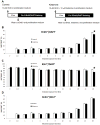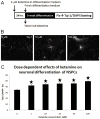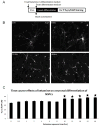Ketamine alters the neurogenesis of rat cortical neural stem progenitor cells
- PMID: 22635046
- PMCID: PMC3507468
- DOI: 10.1097/CCM.0b013e318253563c
Ketamine alters the neurogenesis of rat cortical neural stem progenitor cells
Abstract
Objective: High doses or prolonged exposure to ketamine increase neuronal apoptosis in the developing brain, although effects on neural stem progenitor cells remain unexplored. This study investigated dose- and time-dependent responses to ketamine on cell death and neurogenesis in cultured rat fetal cortical neural stem progenitor cells.
Design: Laboratory-based study.
Setting: University research laboratory.
Subject: Sprague-Dawley rats.
Interventions: Neural stem progenitor cells were isolated from the cortex of Sprague-Dawley rat fetuses on embryonic day 17. In dose-response experiments, cultured neural stem progenitor cells were exposed to different concentrations of ketamine (0-100 µM) for 24 hrs. In time-course experiments, neural stem progenitor cells cultures were exposed to 10 µM ketamine for different durations (0-48 hrs).
Measurements and main results: Apoptosis and necrosis in neural stem progenitor cells were assessed using activated caspase-3 immunostaining and lactate dehydrogenase assays, respectively. Proliferative changes in neural stem progenitor cells were detected using bromo-deoxyuridine incorporation and Ki67 immunostaining. Neuronal differentiation was assessed using Tuj-1 immunostaining. Cultured neural stem progenitor cells were resistant to apoptosis and necrosis following all concentrations and durations of ketamine exposure tested. Ketamine inhibited proliferation with decreased numbers of bromo-deoxyuridine-positive cells following ketamine exposure to 100 µM for 24 hrs (p<.005) or 10 µM for 48 hrs (p< .01), and reduced numbers of Ki67-positive cells following exposure to ketamine concentration>10 µM for 24 hrs (p<.001) or at 10 µM for 48 hrs (p<.01). Ketamine enhanced neuronal differentiation, with all ketamine concentrations increasing Tuj-1-positive neurons (p<.001) after 24-hrs of exposure. This also occurred with all exposures to 10 µM ketamine for >8 hrs (p<.001).
Conclusions: Clinically relevant concentrations of ketamine do not induce cell death in neural stem progenitor cells via apoptosis or necrosis. Ketamine alters the proliferation and increases the neuronal differentiation of neural stem progenitor cells isolated from the rat neocortex. These studies imply that ketamine exposure during fetal or neonatal life may alter neurogenesis and subsequent brain development.
Conflict of interest statement
The authors have not disclosed any potential conflicts of interest
Figures







Comment in
-
Neurotoxicity of ketamine: known unknowns.Crit Care Med. 2012 Aug;40(8):2518-9. doi: 10.1097/CCM.0b013e31825ae442. Crit Care Med. 2012. PMID: 22809932 No abstract available.
Similar articles
-
Ketamine affects the neurogenesis of rat fetal neural stem progenitor cells via the PI3K/Akt-p27 signaling pathway.Birth Defects Res B Dev Reprod Toxicol. 2014 Oct;101(5):355-63. doi: 10.1002/bdrb.21119. Epub 2014 Sep 17. Birth Defects Res B Dev Reprod Toxicol. 2014. PMID: 25231110 Free PMC article.
-
Ketamine inhibits proliferation of neural stem cell from neonatal rat hippocampus in vitro.Cell Physiol Biochem. 2014;34(5):1792-801. doi: 10.1159/000366379. Epub 2014 Nov 14. Cell Physiol Biochem. 2014. PMID: 25427956
-
Ketamine-Induced Toxicity in Neurons Differentiated from Neural Stem Cells.Mol Neurobiol. 2015 Oct;52(2):959-69. doi: 10.1007/s12035-015-9248-5. Epub 2015 Jun 9. Mol Neurobiol. 2015. PMID: 26055230
-
Relationship between ketamine-induced developmental neurotoxicity and NMDA receptor-mediated calcium influx in neural stem cell-derived neurons.Neurotoxicology. 2017 May;60:254-259. doi: 10.1016/j.neuro.2016.04.015. Epub 2016 Apr 27. Neurotoxicology. 2017. PMID: 27132109 Review.
-
Modeling anesthetic developmental neurotoxicity using human stem cells.Semin Cardiothorac Vasc Anesth. 2013 Dec;17(4):276-87. doi: 10.1177/1089253213495923. Epub 2013 Jul 16. Semin Cardiothorac Vasc Anesth. 2013. PMID: 23859832 Free PMC article. Review.
Cited by
-
Neurogenesis and developmental anesthetic neurotoxicity.Neurotoxicol Teratol. 2017 Mar-Apr;60:33-39. doi: 10.1016/j.ntt.2016.10.001. Epub 2016 Oct 14. Neurotoxicol Teratol. 2017. PMID: 27751818 Free PMC article. Review.
-
Ketamine Affects the Neurogenesis of the Hippocampal Dentate Gyrus in 7-Day-Old Rats.Neurotox Res. 2016 Aug;30(2):185-98. doi: 10.1007/s12640-016-9615-7. Epub 2016 Mar 10. Neurotox Res. 2016. PMID: 26966008
-
Positron Emission Tomography with [(18)F]FLT Revealed Sevoflurane-Induced Inhibition of Neural Progenitor Cell Expansion in vivo.Front Neurol. 2014 Nov 17;5:234. doi: 10.3389/fneur.2014.00234. eCollection 2014. Front Neurol. 2014. PMID: 25452743 Free PMC article.
-
Very Low-Dose Sublingual Ketamine for Borderline Personality Disorder and Treatment-Resistant Depression.Cureus. 2024 Apr 5;16(4):e57654. doi: 10.7759/cureus.57654. eCollection 2024 Apr. Cureus. 2024. PMID: 38707115 Free PMC article.
-
PACAP Protects Adult Neural Stem Cells from the Neurotoxic Effect of Ketamine Associated with Decreased Apoptosis, ER Stress and mTOR Pathway Activation.PLoS One. 2017 Jan 26;12(1):e0170496. doi: 10.1371/journal.pone.0170496. eCollection 2017. PLoS One. 2017. PMID: 28125634 Free PMC article.
References
-
- Sinner B, Graf BM. Ketamine. Handb Exp Pharmacol. 2008;182:313–333. - PubMed
-
- Rappaport B, Mellon RD, Simone A, et al. Defining safe use of anesthesia in children. N Engl J Med. 2011;364(15):1387–1390. - PubMed
-
- Ikonomidou C, Bosch F, Miksa M, et al. Blockade of NMDA receptors and apoptotic neurodegeneration in the developing brain. Science. 1999;283(5398):70–74. - PubMed
-
- Scallet AC, Schmued LC, Slikker W, Jr, et al. Developmental neurotoxicity of ketamine: morphometric confirmation, exposure parameters, and multiple fluorescent labeling of apoptotic neurons. Toxicol Sci. 2004;81(2):364–370. - PubMed
-
- Slikker W, Jr, Zou X, Hotchkiss CE, et al. Ketamine-induced neuronal cell death in the perinatal rhesus monkey. Toxicol Sci. 2007;98(1):145–158. - PubMed
Publication types
MeSH terms
Substances
Grants and funding
LinkOut - more resources
Full Text Sources
Research Materials

